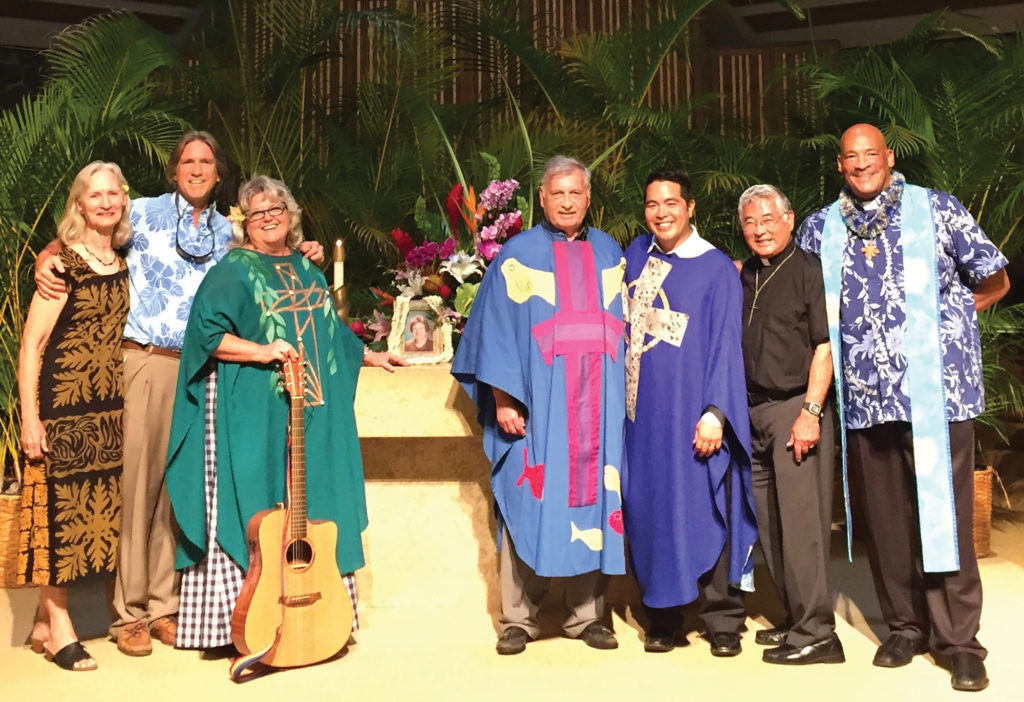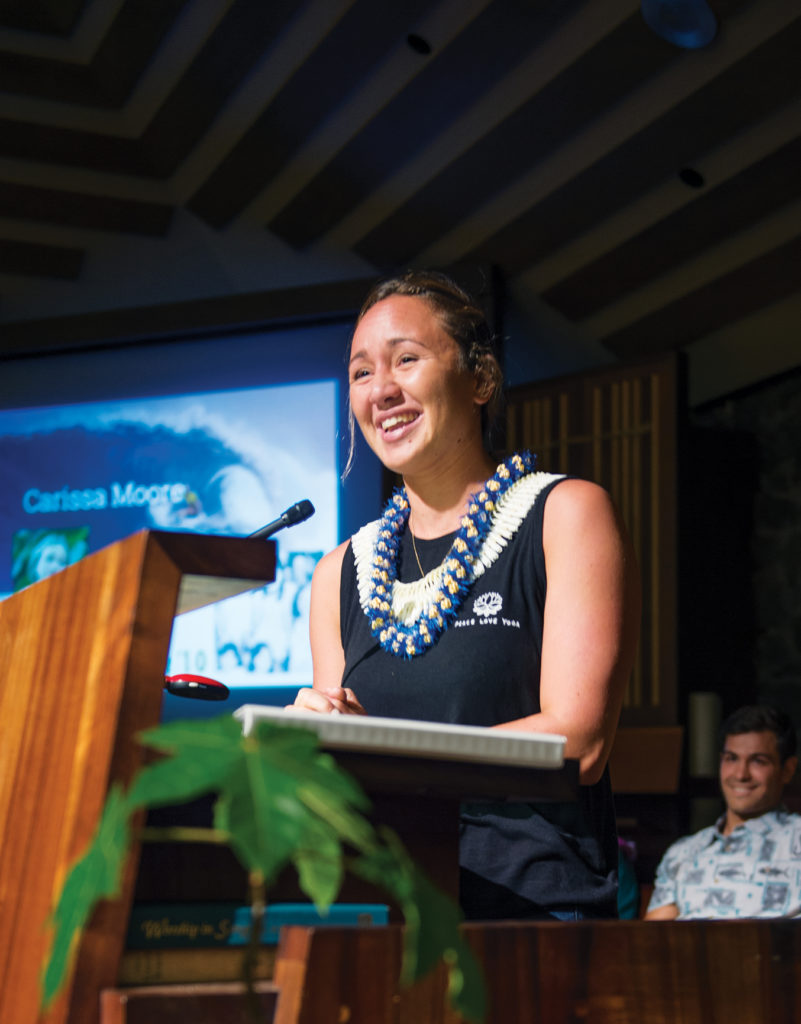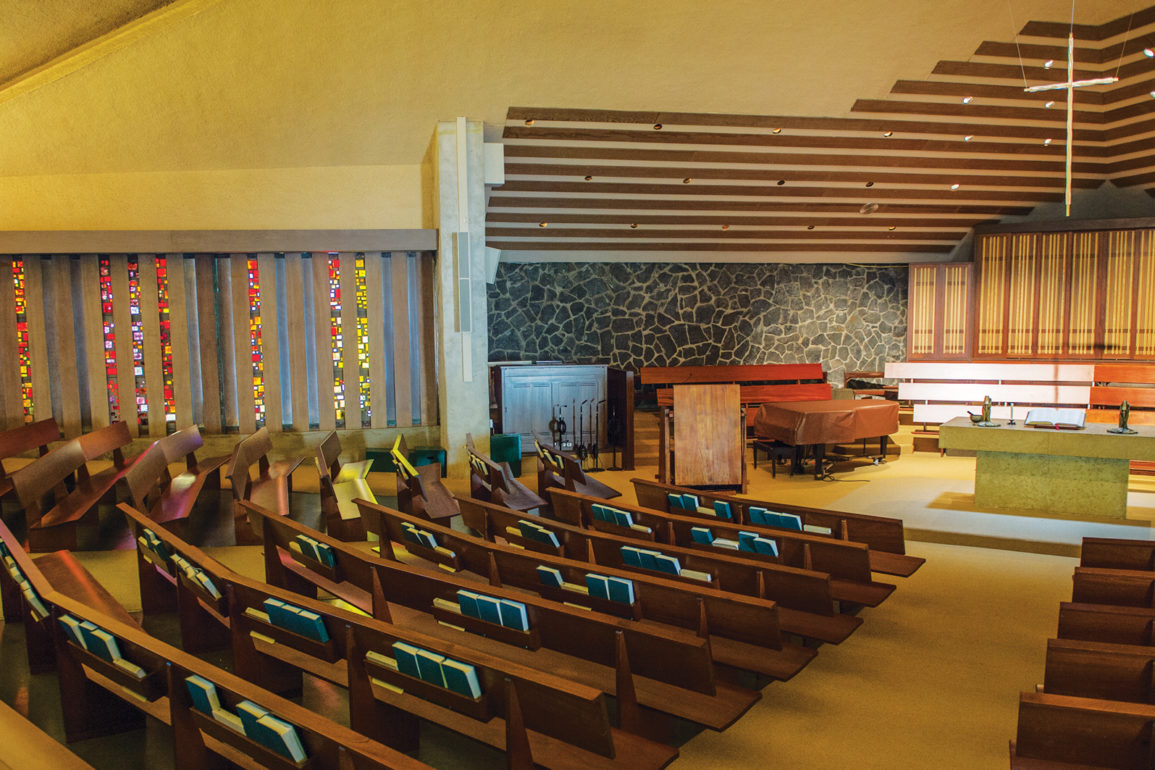By Cynthia Wessendorf
A Time for Celebration and Reflection
Fifty years after Thurston Memorial Chapel opened its doors, hundreds of people gathered to reflect on the Chapel’s vibrant role in the life of the School and to share their memories of this strikingly original structure.

Thurston Memorial Chapel was realized with a gift to the School from Mr. and Mrs. Robert Thurston in memory of their son, Robert Shipman Thurston Jr., a 1941 Punahou graduate and fighter pilot killed in World War II.
For Punahou president, Dr. James K. Scott ’70, the Chapel was a place to seek comfort in the wake of shattering events, such as the assassinations of Martin Luther King Jr. and Bobby Kennedy in 1968, and the shooting deaths of anti-war protesters at Kent State University in 1970. “And early in the morning on Sept. 11, 2001, we instinctively gathered here,” recalled Scott at the Chapel’s 50th anniversary celebration held on Jan. 22, 2017.
Punahou Trustee Kitty Sullivan ’75 Wo remembered quiet moments from childhood as she marveled at the building’s immersion in the Lily Pond, with its circling fish, or watched the light dance through the Chapel’s stained-glass windows. “Thought-provoking metaphors and lessons in nature, science, art and Christianity are embedded in every aspect of the building,” she told the audience.
For Class of 1967 alumni Suzanne Sato and James Tam, who participated in the Chapel’s dedication as seniors, the Chapel’s role extends far beyond the confines of school. “For 50 years, the Punahou ‘ohana has married, welcomed new lives and bid a final aloha to family and old friends of this place,” said Tam. Sato echoed: “It has been a haven and the heart of Punahou.”
Gifts to the Chapel
The coral altar honors the memory of the late Leo Piper, longtime director of Physical Plant, and is a gift of the Class of 1965. The suspended cross is a gift of the Class of 1966. Floor candlesticks and chalice are memorials to Ric McCarthy ’66. Bronze altar candlesticks and chalice, created by local artist Michael Tom, are memorials to Jerome Peacock ’41, given by his daughter Nancy Peacock ’72. The current altar Bible is dedicated to Dr. Raymond and Mrs. Estelle Kan Kong, with appreciation for their 1996 endowment gift for spiritual education and the healing power of prayer. The new Allen organ was funded in part by a grant from the McInerny Foundation in 2016, replacing the organ gifted by Dr. Hung Wo and Elizabeth Lau Ching.
‘A Hawaiian Cloister’
Marking the geographic and spiritual center of the School, the building of Thurston Memorial Chapel was the work of many visionaries.

Designed by one of Hawai‘i’s best-known architects, Russian-born Vladimir Ossipoff, the Chapel merges his artistic sensibility with a focus on site-specific and sustainable construction. Built into Ka Punahou, the New Spring, the structure literally merges the Christian heritage of the School with this fabled body of water, which inspired Hawaiian legends and served as a crucial water source for the School.
Dean Sakamoto, an expert on Ossipoff and author of “Hawaiian Modern,” describes the design as an archetype of the architect’s work:
“It is at once Hawaiian, modern, and timeless. Ossipoff’s opportunity to build this memorial at Punahou came after nearly 30 years of practice, a good deal of it characterized by his skill at marrying modern methods and local conditions. At the Chapel he found a solution that cannot be traced to any visual precedent.”
A team of skilled artists worked with the architect. The stained-glass windows, which extend to the water’s edge and add a rainbow of color to the interior and exterior, were created by German-born artist Erica Karawina, and the woven screens were crafted by Ruth Adell-Anderson.
Lining the Chapel’s koa entrance doors are a series of 32 copper repoussé panels, “Episodes from the Life of Christ.” The images were designed by French-born artist Jean Charlot and crafted by his long-time collaborator, metal artist Evelyn Giddings, who still resides in Manoa.
The panels resemble many of the medieval church doors of Europe, such as Lorenzo Ghiberti’s renowned doors to the Baptistery of Saint John in Florence. Charlot’s son and biographer, John Charlot, believes the handcrafted doors may be the only ones of their kind in the country. Like much religious art, they tell a visual story – Christ’s birth, life, death, resurrection and continual spiritual presence – and anchor the Chapel in a millennia-old tradition of craftsmanship. The 32 screens were selected from suggestions by Junior School students.
In his dedication address in 1967, Ossipoff described this singular creation:
“I hope that a sense of belonging has been achieved, a sense that this building – the court and lanais which surround it, forming what might even be called a ‘Hawaiian Cloister’ – is a special and unique part of the campus. I hope too that those students who occasionally may feel the need for physical and spiritual shelter will naturally gravitate here, and that having come here, they will find the comforting solace they seek.”
Chapel Roots
Since Punahou’s founding in 1841, religious instruction has animated its mission and curriculum. Daniel Dole, the first principal, also served as religious leader, as did subsequent heads of school for nearly a century. Students incorporated daily devotions, Bible study and Sunday services into their traditional academic studies.
By the 1930s, though, the administrative and spiritual leadership had separated, and the first independent chaplains were hired. While Christian education continued to be taught, the curriculum had opened to include Judaism and world religions courses. Services were held at different locations on campus, including Dillingham Hall, McNeil Auditorium, Montague Hall and even outdoors.
While the School had long hoped for a dedicated chapel, it was not until 1964 that those aspirations began to materialize with a gift from Mr. and Mrs. Robert Thurston in memory of their son, Robert Shipman Thurston Jr., a 1941 Punahou graduate and fighter pilot killed in World War II. Spearheaded by longtime advocate, Rev. Kenneth O. Rewick (1949 – 1965) and overseen by newcomer Rev. R. David Steele (1965 – 1978), construction moved forward. Heavy rains the following spring raised the Lily Pond’s water level and caused delays as crews worked to lay the building’s foundation. Finally, on Jan. 22, 1967, the completed Chapel was dedicated.

Two years later when Rev. Dr. John Heidel arrived from Central Union Church, the School’s approach to religious education had shifted away from traditional “right belief and absolute belief” to embrace a more inclusive environment that accommodated the diverse student body. “The charter says every child is supposed to have a Christian education. We interpreted that as accepting all people and all religions, which is what Jesus did,” said Heidel, now retired.
Even today, Heidel is a restless champion of progressive causes. He brought that energy and outlook to his 30-year tenure as a Punahou chaplain, questioning the Vietnam War, advocating for prison reform, cautioning against video game violence, and striving to formulate a contemporary theology that helped people grow spiritually and find moral direction.
That quest to define religious belief in modern terms continues to this day. “What makes us different is that we weren’t started by a denomination or an order or diocese,” says one of the three current chaplains, Joshua Hayashi. “So the emphasis of the School from its very inception is not about keeping doctrine, but to go out into the world. This comes from the missionaries, I think. The Chapel is the place where people get the encouragement, the spirit and the love to do that.”
New Directions
In the 1990s, Heidel and former ethics teacher Marion Lyman-Mersereau ’70, who now teaches eighth-grade social studies, launched a character education initiative that is still used in Chapel and classroom lessons. Inspired by Thomas Lickona’s “Educating for Character,” the Punahou team adapted the ideas into an original curriculum, published as the four-volume “Character Education.”
The program spotlights a different value each month – such as ho‘ihi (respect), kupa‘a (commitment), kupono (honesty) and laulima (cooperation) – and encourages students to think about the values through discussion, activities and service projects. As Chaplain Lauren Buck Medeiros describes it, Punahou’s character education program is the scaffolding on which the Chapel lives its mission. “A well-articulated character education program can be the bridge between religious education and the educational vision. Though particular beliefs might vary, no one would argue that we want our students to have good character.”

For Heidel, an emphasis on positive values can also help subvert entrenched markers of success. “If the main values of society are wealth, power, security and prestige, people base their lives on those values,” he said. “If I had a hidden agenda in Chapel, it was to change that value structure. Which is why Marion and I came up with this character education curriculum – to suggest primary values that would encourage people to be respectful, responsible, honest and compassionate.”
Medeiros credits character education and an embrace of diversity with the Chapel’s ongoing effectiveness, particularly in an age where a third of young adults identify as religiously unaffiliated “nones.” “When many schools are searching for ways to address social-emotional learning, Punahou is blessed to have a chapel program committed to educating the head, heart and hands of our students,” said Medeiros.
The Thurston Memorial Chapel maintains a central position in the Punahou experience, blending traditional programming with new forms of outreach.
Touching Lives
Today, Rev. Medeiros, Rev. Hayashi and Rev. Dr. George Scott are involved in nearly every aspect of the School’s spiritual, emotional and cultural life. When the seniors prepare to graduate, they gather for a final emotional farewell in the Chapel. When the youngest students reach second grade, they muster their theatrical skills to perform the beloved Christmas program. When faculty and staff retire, their colleagues honor their years of service in the Aloha Ceremony held annually in the Chapel.
Beyond annual events such as these, the chaplains lead daily services that students attend each cycle. For the younger grades, Medeiros helps organize the many student-led chapels, which involve researching and writing, public speaking, acting and music. Chapel becomes the ideal forum for developing the confidence and presence for which Punahou students are known.

She also helped to organize this year’s Spirit and Service Speaker Series in conjunction with the Luke Center for Public Service, which most recently welcomed world surf champion Carissa Moore ’10 to talk about finding one’s passion, body image and charitable acts. A variety of special guests are regularly invited to share their unique stories in Chapel, including, most famously, then-Senator-elect Barack Obama ’79, who spoke with students about the value of public service in a December 2004 address.
Beyond the Chapel’s walls, the three chaplains are deeply involved in the School community, allowing them opportunities to connect with students on a personal level. Among many roles, Rev. Scott works with a therapy dog named Moose to help students with anxiety, leads ninth-grade guidance and camp experiences, and ministers to athletes as a football coach. Hayashi counsels middle-schoolers on personal issues, organizes faculty and staff basketball sessions, and works with an eighth-grade mixed choir to create mash-ups about justice.
“Someone described us as being the glue on campus,” said Hayashi as he talked about their efforts to build relationships with each individual, and their continual tacking between traditional religious messages and reaching people where they live. Scott elaborates: “Because we’re such a diverse community, where some are Jewish or Buddhist or don’t claim anything, it’s a balancing act. It’s important that people see us as able to walk between the lines.”
Fifty years ago, at the Thurston Memorial Chapel’s opening ceremony, Ossipoff described a key element of his design: “Generous eaves extend from the building, and [a child must go] down a few steps to gain their shelter, and tucks under them as a little chick must do when seeking shelter under its mother hen’s outspread wings.”
That feeling of protective sanctuary permeates the building and dovetails with the Chapel’s mission to serve a wide network of students, faculty and alumni, who represent varied cultures, ethnicities and religions.
When the frenetic activity of the day overwhelms, the Chapel offers a chance to step away and find a moment of calm. “This is a place that we come to be comforted when we’re not feeling great,” says Medeiros. “One of the real gifts of the Chapel is being a place we can just breathe.”
Cynthia Wessendorf is a freelance writer and editor, and the parent of a current Punahou student.

